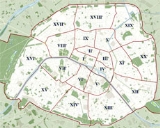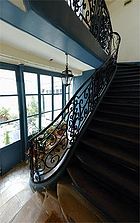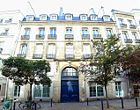
Rue de la Harpe, Paris
Encyclopedia
The rue de la Harpe is a street in Paris' Latin Quarter
. Relatively calm and cobblestoned along much of its length, it runs in a south-easterly direction between the rue de la Huchette
and the rue Saint-Séverin
, where it turns south-west to where it ends at the boulevard Saint-Germain. It is a largely residential street; it is graced through its odd numbers (eastern side) with a few buildings dating from the Louis XV period, but buildings along the opposite side of the street are most all of a 'Haussmannian'
style of a more recent stature. Its street-front commerces are varied to its southern end, but tend towards restaurants and the tourism trade towards the river. It appeared in the 19th century magazine, The Tell Tale, as the site of the murders which may have been the origin of the Sweeney Todd
story.
, dates from Roman times. Leaving Lutèce's (Roman Paris') main north-south thoroughfare just below the Petit-Pont it turned south to become a roadway parallel to the first known as the "via inferior" ("lower road"). Before it was cut short below the Boulevard Saint-Germain by the construction of the Boulevard Saint-Michel from 1859, it continued under more or less the same name until Paris' former 12th-century 'Porte Saint-Michel" gate at the corner of today's rue Soufflot and Boulevard Saint-Michel. The rue de la Harpe's 'newer' westward twist above the rue Saint-Séverin
owes its existence to first a "bac" footbridge crossing the river from its end, then the construction of the first version of the pont Saint-Michel from 1378.
Former Names: To the south of the rue Saint-Séverin
, the rue de la Harpe has been known as: "rue de la Juiverie", "rue de la Vielle Juiverie," "vicus Cithare in Judearia" (1247), "vicus Judeorum" (1257), "vicus Harpe (1270)", "vicus Herpe" ou "vicus de Cithara" (1254), and finally "rue de la Herpe" or "Harpe." Beyond Paris' 12th-century walls it became "rue Neuve Outre la Porte Saint-Michel" or simply the "rue d'Énfer" (literally "street of Hell").
In its section between the rue Saint-Séverin
and the river was named: "Vicus Reginaldi Citharatoris" (1247), "vicus Reginaldi dicti le Harpeur" (1265), "vicus Vetus Bouclearia", "vicus Vetus Judearia", "rue de la Vielle Boucherie" (1272), "rue de la Petite Bouclerie" (1300), "rue de l'Abreuvoir Mascon" (1391), "rue Neuve Mâcon" or "rue de l'Abreuvoir Mâcon" (1401), "rue de l'Abreuvoir Mâcon" or "rue Neuve Saint-Michel" (1409), "rue Neuve du pont Saint-Michel" or "de la Bouclerie" (1406), "rue de la Grant Bouclerie" (1405), "rue Neuve Saint-Michel" (1469) and "rue de la Vielle Bouclerie".
In 1800, Joseph Fouché
, the Parisian chief of police, documented a series of murders undertaken by a barber and baker on this street. They are often cited as the first serial killers, and also it is argued that the pair were a significant influence in the famous story of the barber Sweeney Todd
of Fleet Street, London, and his baker accomplice Mrs. Lovett. The French story, however, smacks of being an urban myth and the supposed book by Fouché is impossible to trace. The earliest version of the story claims "This case was of so terrific a nature, it was made part of the sentence of the law, that besides the execution of the monsters upon the rack, the houses in which they perpetrated those infernal deeds, should be pulled down, and that the spot on which they stood should be marked out to posterity with horror and execration." About six years before this story appeared, two houses on the street had been torn down to allow access to the ruins of the Thermes de Cluny.
It is suspected this may have fed or sparked the rumor.





Latin Quarter
Latin Quarter is a part of the 5th arrondissement in Paris.Latin Quarter may also refer to:* Latin Quarter , a British pop/rock band* Latin Quarter , a 1945 British film*Latin Quarter, Aarhus, part of Midtbyen, Aarhus C, Denmark...
. Relatively calm and cobblestoned along much of its length, it runs in a south-easterly direction between the rue de la Huchette
Rue de la Huchette, Paris
The rue de la Huchette is one of Paris' oldest Rive Gauche streets. Running eastward just below the Seine river from the Place Saint-Michel, it is today an animated Latin Quarter artery with one of the highest concentrations of restaurants in the city — Greek specialties predominating...
and the rue Saint-Séverin
Rue Saint-Séverin, Paris
The rue Saint-Séverin is a sometimes boisterous street running parallel to the river in the north of Paris' Latin Quarter. Lined with restaurants and souvenir shoppes, much of its commerce is dedicated to tourism.-Name Origin:...
, where it turns south-west to where it ends at the boulevard Saint-Germain. It is a largely residential street; it is graced through its odd numbers (eastern side) with a few buildings dating from the Louis XV period, but buildings along the opposite side of the street are most all of a 'Haussmannian'
Baron Haussmann
Georges-Eugène Haussmann, commonly known as Baron Haussmann , was a French civic planner whose name is associated with the rebuilding of Paris...
style of a more recent stature. Its street-front commerces are varied to its southern end, but tend towards restaurants and the tourism trade towards the river. It appeared in the 19th century magazine, The Tell Tale, as the site of the murders which may have been the origin of the Sweeney Todd
Sweeney Todd
Sweeney Todd is a fictional character who first appeared as then antagonist of the Victorian penny dreadful The String of Pearls and he was later introduced as an antihero in the broadway musical Sweeney Todd: The Demon Barber of Fleet Street and its film adaptation...
story.
History
The rue de la Harpe below its twist to the west at the rue Saint-SéverinRue Saint-Séverin, Paris
The rue Saint-Séverin is a sometimes boisterous street running parallel to the river in the north of Paris' Latin Quarter. Lined with restaurants and souvenir shoppes, much of its commerce is dedicated to tourism.-Name Origin:...
, dates from Roman times. Leaving Lutèce's (Roman Paris') main north-south thoroughfare just below the Petit-Pont it turned south to become a roadway parallel to the first known as the "via inferior" ("lower road"). Before it was cut short below the Boulevard Saint-Germain by the construction of the Boulevard Saint-Michel from 1859, it continued under more or less the same name until Paris' former 12th-century 'Porte Saint-Michel" gate at the corner of today's rue Soufflot and Boulevard Saint-Michel. The rue de la Harpe's 'newer' westward twist above the rue Saint-Séverin
Rue Saint-Séverin, Paris
The rue Saint-Séverin is a sometimes boisterous street running parallel to the river in the north of Paris' Latin Quarter. Lined with restaurants and souvenir shoppes, much of its commerce is dedicated to tourism.-Name Origin:...
owes its existence to first a "bac" footbridge crossing the river from its end, then the construction of the first version of the pont Saint-Michel from 1378.
Former Names: To the south of the rue Saint-Séverin
Rue Saint-Séverin, Paris
The rue Saint-Séverin is a sometimes boisterous street running parallel to the river in the north of Paris' Latin Quarter. Lined with restaurants and souvenir shoppes, much of its commerce is dedicated to tourism.-Name Origin:...
, the rue de la Harpe has been known as: "rue de la Juiverie", "rue de la Vielle Juiverie," "vicus Cithare in Judearia" (1247), "vicus Judeorum" (1257), "vicus Harpe (1270)", "vicus Herpe" ou "vicus de Cithara" (1254), and finally "rue de la Herpe" or "Harpe." Beyond Paris' 12th-century walls it became "rue Neuve Outre la Porte Saint-Michel" or simply the "rue d'Énfer" (literally "street of Hell").
In its section between the rue Saint-Séverin
Rue Saint-Séverin, Paris
The rue Saint-Séverin is a sometimes boisterous street running parallel to the river in the north of Paris' Latin Quarter. Lined with restaurants and souvenir shoppes, much of its commerce is dedicated to tourism.-Name Origin:...
and the river was named: "Vicus Reginaldi Citharatoris" (1247), "vicus Reginaldi dicti le Harpeur" (1265), "vicus Vetus Bouclearia", "vicus Vetus Judearia", "rue de la Vielle Boucherie" (1272), "rue de la Petite Bouclerie" (1300), "rue de l'Abreuvoir Mascon" (1391), "rue Neuve Mâcon" or "rue de l'Abreuvoir Mâcon" (1401), "rue de l'Abreuvoir Mâcon" or "rue Neuve Saint-Michel" (1409), "rue Neuve du pont Saint-Michel" or "de la Bouclerie" (1406), "rue de la Grant Bouclerie" (1405), "rue Neuve Saint-Michel" (1469) and "rue de la Vielle Bouclerie".
In 1800, Joseph Fouché
Joseph Fouché
Joseph Fouché, 1st Duc d'Otrante was a French statesman and Minister of Police under Napoleon Bonaparte. In English texts his title is often translated as Duke of Otranto.-Youth:Fouché was born in Le Pellerin, a small village near Nantes...
, the Parisian chief of police, documented a series of murders undertaken by a barber and baker on this street. They are often cited as the first serial killers, and also it is argued that the pair were a significant influence in the famous story of the barber Sweeney Todd
Sweeney Todd
Sweeney Todd is a fictional character who first appeared as then antagonist of the Victorian penny dreadful The String of Pearls and he was later introduced as an antihero in the broadway musical Sweeney Todd: The Demon Barber of Fleet Street and its film adaptation...
of Fleet Street, London, and his baker accomplice Mrs. Lovett. The French story, however, smacks of being an urban myth and the supposed book by Fouché is impossible to trace. The earliest version of the story claims "This case was of so terrific a nature, it was made part of the sentence of the law, that besides the execution of the monsters upon the rack, the houses in which they perpetrated those infernal deeds, should be pulled down, and that the spot on which they stood should be marked out to posterity with horror and execration." About six years before this story appeared, two houses on the street had been torn down to allow access to the ruins of the Thermes de Cluny.
Thermes de Cluny
Thermes de Cluny are an ancient Gallo-Roman ruin lying in the heart of Paris' 5th arrondissement and which are partly subsumed into the Musée de Moyen Age-Hôtel de Cluny....
It is suspected this may have fed or sparked the rumor.
Constructions of note
- 35 - Building dating from the Louis XV period; much of it is protected under a "Historical Monument" appellation. This property has the particularity of having a winding series of courtyards that lead to an adjoining property at 20, rue de la Parchemenerie.



- 45 - Building dating from the late 18th century - only its façade has been classed "Monument Historique".



